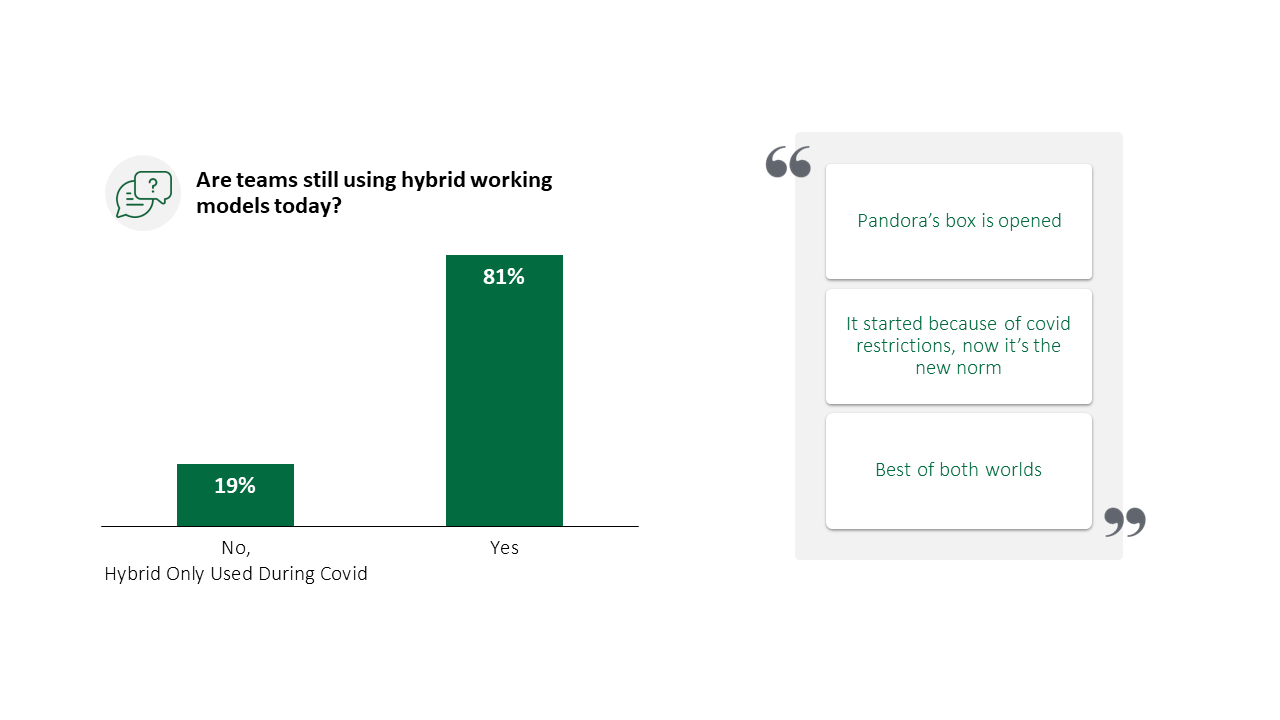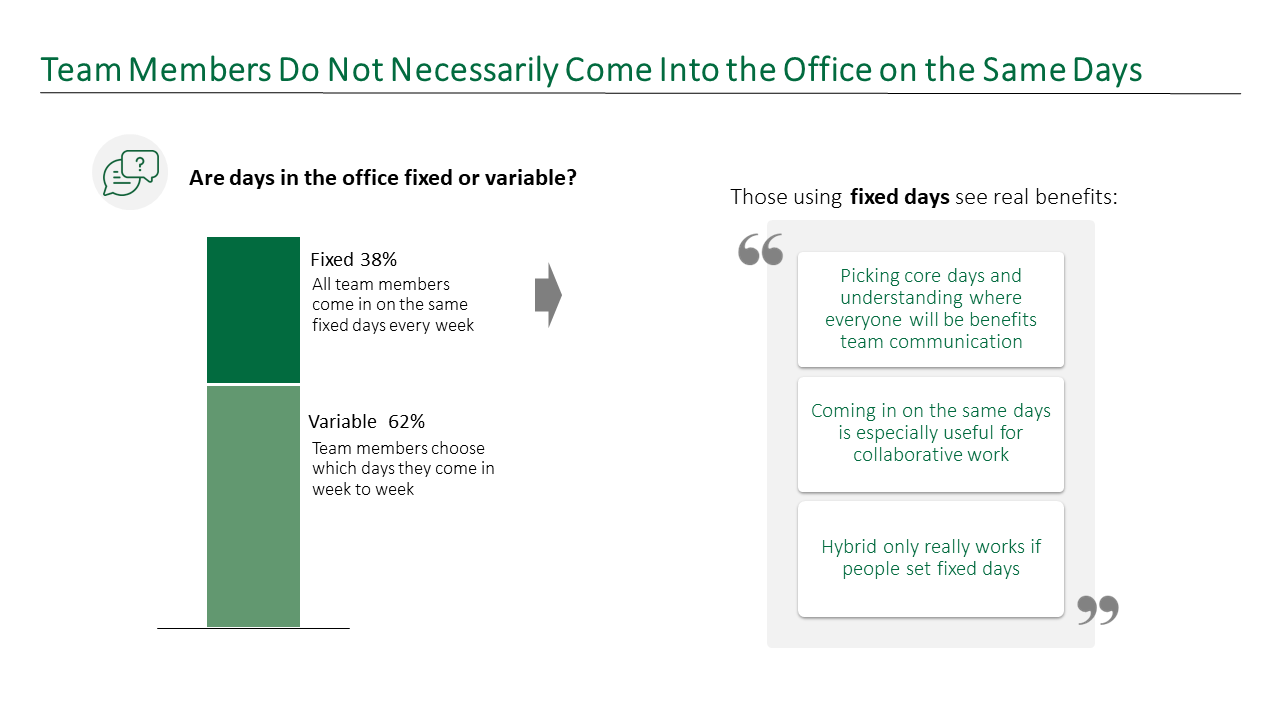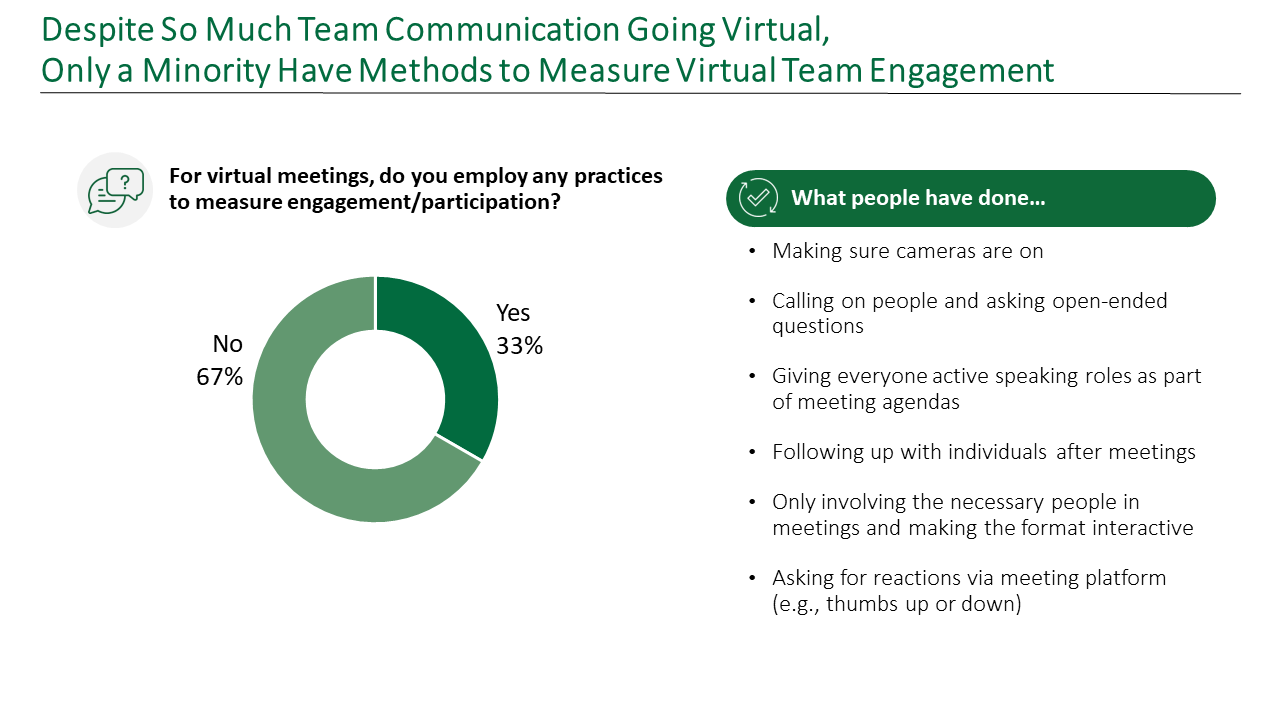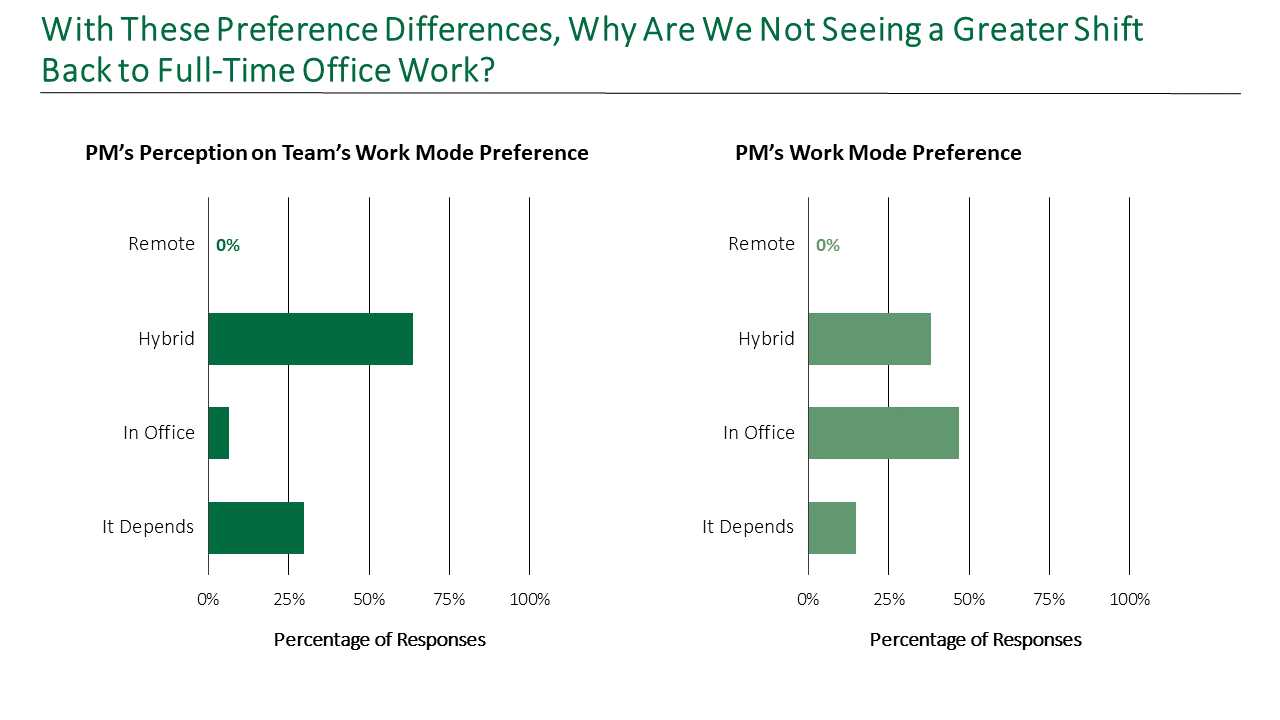Hybrid Working and Capital Project Teams
From early 2020 to mid-2021, the COVID-19 pandemic forced many project teams into a new, daily routine of working from home. A 2020 IPA survey showed that this switch to remote working drove a self-perceived hit in team efficiency and productivity. As restrictions started to lift, a new mode, hybrid working, emerged, which involved having employees work partially from home and partially from the office or the field. This mode proved useful in allowing access to the office while limiting exposure to the virus. When this melded working method was introduced, many saw it as the first step in a gradual transition back to full-time office or field work—in other words, back to normal. In practice, hybrid working continued to evolve as a flexible working arrangement and is now considered a norm for many employees. In the post-pandemic era, hybrid working is often considered to be at the crux of what many are referring to as the new normal—at least in the workplace. And capital projects are no exception.
Unlike most aspects of business, projects are almost completely team-based activities. Can hybrid working work for owner project teams? That is our subject below.
What IPA Discovered About Hybrid Work
IPA recently interviewed 48 project managers and capital project leaders to discuss their company’s hybrid working policies and how these policies manifest in day-to-day project work. Feedback from these interviews shows that hybrid working has indeed become an industry norm in project work, with the vast majority of project managers indicating that they are still using hybrid working models today.

Those that have returned to the office have emphasized the importance of maximizing face-to-face interaction for project work, and the advantages that team colocation provides in terms of informal communication channels and resolving issues quickly. For companies where hybrid work has persisted, the most common reasons given emphasize the fact employees now expect to be given this flexibility, though we know there are likely other corporate drivers at play. For example, many companies are using the high uptake of hybrid work as a justification to downsize office space, which can provide an immediate boost to the bottom line, but with long-term consequences. Indeed, IPA has learned that some existing project office locations are planning to close within the next year, which will leave some employees with no choice but to endure very long commutes in order to get face time with colleagues.
On the other hand, for an industry where talent is in short supply, flexible working arrangements can allow companies to broaden their recruitment reach, though we have yet to see strong consideration for how distant or remote employees will be onboarded effectively. Although this may not be as big of an issue for seasoned professionals, it is concerning for more junior employees for whom much of the learning takes place on the job and through interactions with more senior colleagues.
Corporate drivers aside, for an industry where success depends on work done by cross-functional teams, not just the tenacious efforts of individuals, are project organizations doing enough to ensure hybrid working models can actually deliver capital effectively?
Hybrid Working Models for Capital Projects
Hybrid working really is a catch-all term, and our interviews revealed that its implementation varies widely across capital project systems. When it comes to the number of days that employees are expected to be in the office or in the field, this ranges from no strict requirements to 4 days in the office, although 2 to 3 days appears to be the norm. In many cases, the number of days is set by a blanket corporate policy, which does not provide project managers with the authority to optimize working models for their teams as appropriate. In some cases, hybrid working arrangements are at the discretion of functional managers, meaning working arrangements can differ across the project organization and between team members.
This is concerning given that the main point of coming into an office, plant, or field location for project professionals is to maximize the effectiveness of collaborative work and communication with other team members, not simply to turn on the computer from another location. Only 38 percent of those interviewed had measures in place that ensured team members were coming to the office on the same working days each week—what we have termed fixed working days. For some project teams, there were no defined conditions or meetings at all that required in-person attendance by all team members, such as constructability reviews or milestone meetings.

Project managers with fixed working days for their teams see tremendous benefits to this approach, with some going so far as to say this is the only way you can actually make hybrid work for projects. While in theory individualized tasks can be done quite efficiently from anywhere, there is no substitute for face-to-face interaction when it comes to collaborative work. There is also no substitute for being able to walk down the hall and get the information you need to make an informed decision in real time. While most of the people (non-managers) we interviewed did not feel that hybrid working was having a negative effect on decision quality, 40 percent did acknowledge that decision-making was slower.
Most Communication Is Going Virtual
If you discuss hybrid working with enough people, one of the common phrases you hear is this idea that hybrid allows us to get the best of both worlds. However, our interview results show that many of us may be diminishing the value of one of those worlds by not capitalizing on opportunities for team members to get face time with each other. And we are indeed seeing that communication norms for teams are shifting more and more toward virtual means, even when people are in the office. It is often perceived as more of a hassle to even get people together for a meeting face to face. It can be difficult to find an available conference room (could office downsizing be at play?); people tend to be in back-to-back meeting marathons, making it difficult to get to a physical meeting location on time; and some just don’t want to show up if there is an option to join via a virtual link.
With so much virtual communication, one of the biggest challenges is how to ensure all team members are fully engaged and fully aligned. In face-to-face communication, there are numerous non-verbal cues that signal miscommunication—or that someone has completely checked out. It’s hard to miss someone’s eyes glazing over or the perplexed look of a colleague when everyone is in the room together. Virtual communication also introduces the additional challenge of meeting participants multitasking. Many project managers have come to loathe the phrase, “Can you repeat the question?” while also admitting to succumbing to the temptation of multi-tasking during meetings themselves. Only about a third of project managers we spoke to had developed their own tactics for ensuring team members were engaged in virtual meetings.

Such tactics include things like ensuring everyone has a speaking role during key meetings to limiting meeting attendance to only the key participants to making sure everyone keeps their cameras on. While keeping cameras on, at least for smaller meetings, seems like a pretty straightforward way to bring in some non-verbal communication to the virtual environment, very few teams had strict requirements for doing so, and about half tend not to use their cameras as a general norm.
Hybrid Working Provokes Mixed Feelings
Although it has become an expectation for many project team members, project managers still have mixed feelings about its efficiency. About 60 percent of project managers believe their team members prefer hybrid working models over full-time office work or fully remote working, with about a third saying the preference really depends on the individual. However, when asked about their own personal preference, about half of the project managers we spoke to would prefer to have all team members back in the office full-time versus 38 percent who are happy with hybrid working setups. Most of the reasons given for wanting more face time were around the softer side of team dynamics, such as relationship building and team cohesiveness. Problems, and especially interpersonal conflict, are also much harder to resolve in a virtual environment. Some project managers feel that the makeup of the team can really influence how they feel about hybrid working, citing, for example, that more junior employees may benefit from being in the office.

So, while some project managers are embracing hybrid working as a flexible working arrangement, others feel trapped in this new way of working due to hybrid working policies that have been imposed upon them, or out of fear of losing resources in an already difficult market. About 70 percent of project managers felt they would lose people if the company were to take away hybrid working options, though the companies we spoke to that have mandated a return to office had not experienced a mass exodus of employees.
The Future of Hybrid Work
Adopting hybrid working constitutes a significant operating model change; however, for most of the capital projects industry, hybrid working was introduced only circumstantially—in response to COVID‑19 restrictions. If organizations want to fully embrace hybrid working, this change needs to be managed like any other major change initiative: with deliberate intent and in such a way that organizations can identify what works and what does not. Most project organizations have not taken these steps.
The way hybrid working is implemented also needs to be aligned with corporate strategy and the work being done. Adopting a one-size-fits-all approach to hybrid working—one in which a single hybrid working policy is applied to the entire organization—may appear easier to roll out, but falls short in accommodating the nuances of project work. For one, it fails to consider whether the model is appropriate for all types of work and tasks—which are never uniform across all job functions that make up an organization. Furthermore, it undercuts the authority of project managers and other leaders to manage and integrate project teams in alignment with project priorities, which invariably shift throughout a project’s lifecycle.
In order for the industry to establish Best Practices for hybrid working, organizations must first define what hybrid work will look like for capital projects, including the rules and norms that project personnel will follow. In establishing well-defined parameters for these working conditions, organizations must consider:
- Which tactics, rules, or norms can mitigate the losses associated with less face-to-face time? When must in-person work be prioritized?
- Are there any roles, tasks, or activities that are more suited to hybrid working than others?
- How do team member roles and responsibilities and core competencies need to change?
- How will we train and develop newcomers?
- How will we build relationships with and integrate new team members?
- Does anything else in our project system (work process, organizational setup, information management systems, etc.) need to change to make this effective?
- How will we measure the effectiveness of our hybrid working models, collect lessons learned, and incorporate learnings about hybrid working back into our systems?
Going forward, IPA will continue to track and monitor the implementation of hybrid working on capital projects in order to measure the effects of hybrid working on project success and determine whether there are any Best Practices that can be employed by the industry to promote strong team integration and good project outcomes. In the meantime, our research has shown that the burden of mitigating any downsides associated with hybrid work will fall very much on our project managers. The ability of project managers to excel at both project management and people management, communication, and leadership will become increasingly important.
Contact us through the web from below to start a discussion about how to optimize the staffing, competence, and structure of your project organization and teams.